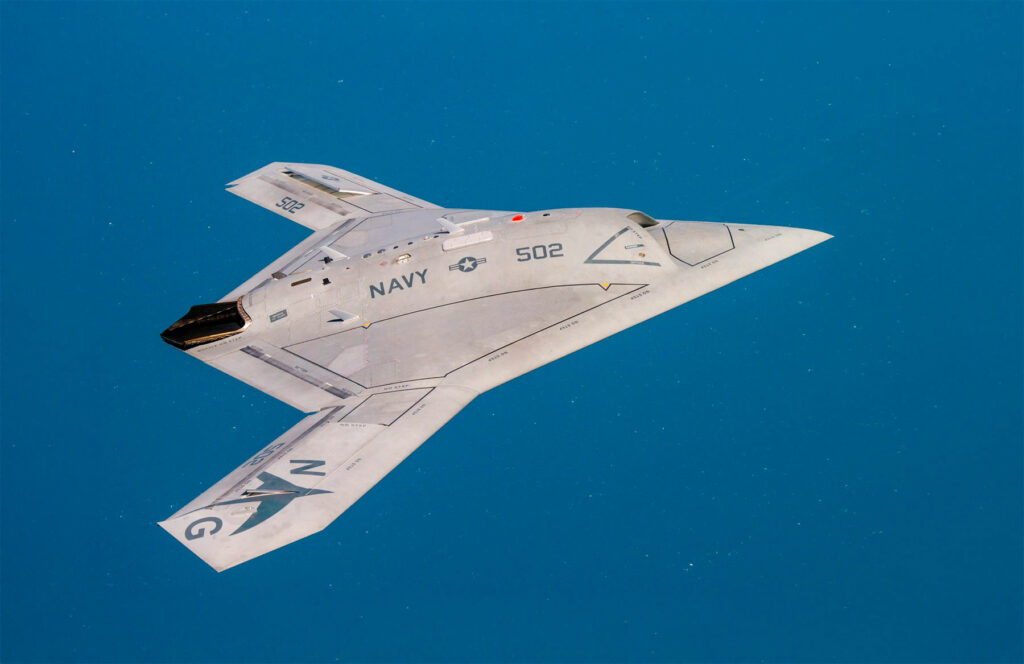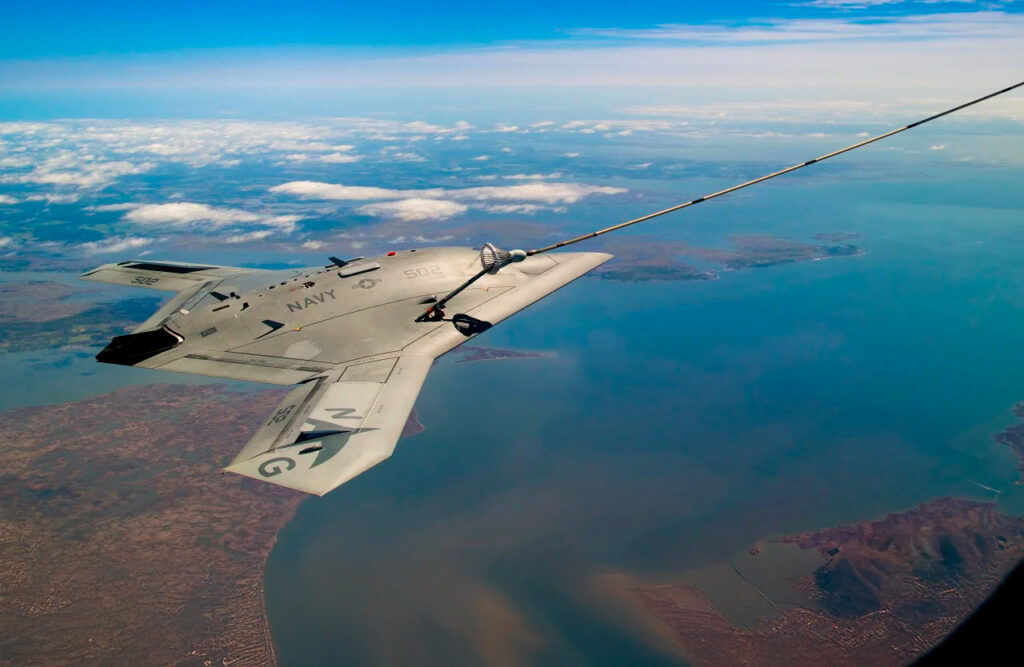Northrop Grumman X-47B: Autonomous, tailless UCAV, pioneering carrier-based launches and aerial refueling, with advanced stealth and ISR capabilities.
In brief
The X-47B, developed by Northrop Grumman, is an unmanned combat air vehicle (UCAV) designed for carrier-based operations. It was created under the U.S. Navy’s Unmanned Combat Air System Carrier Demonstration (UCAS-D) program. Equipped with a Pratt & Whitney F100-PW-220U engine, the X-47B can reach speeds up to Mach 0.9 and operate at ranges exceeding 2,100 nautical miles (3,900 km). Its tailless design and stealth characteristics reduce radar detectability, while its autonomous flight control system allows it to execute complex missions, including takeoff, landing, and aerial refueling, without human intervention. The X-47B’s dual internal weapon bays can carry up to 4,500 pounds (2,040 kg) of ordnance, making it versatile for ISR (Intelligence, Surveillance, Reconnaissance) and strike missions. It completed its primary demonstration missions by 2015, including the first autonomous aerial refueling, setting the stage for future carrier-compatible unmanned systems.

The Northrop Grumman X-47B
The Northrop Grumman X-47B is a significant technological milestone in the evolution of autonomous aircraft for combat and reconnaissance. This UCAV is notable for being the first unmanned system designed to operate from an aircraft carrier, achieving several firsts in the field of aviation, including autonomous carrier takeoff, landing, and aerial refueling. Developed under the UCAS-D program with the U.S. Navy, the X-47B aims to demonstrate the feasibility of integrating unmanned systems with traditional carrier air wings. Its capabilities extend to ISR, electronic warfare, and strike operations, showing promise for future unmanned aerial combat roles within the U.S. Navy.
History of Development
The X-47B UCAV program began as a joint initiative between the U.S. Air Force and Navy under the Joint Unmanned Combat Air Systems (J-UCAS) program, initially managed by DARPA. With Northrop Grumman as the primary contractor, development of the X-47 series began around 2001, focusing on creating a low-observable UCAV capable of autonomous operation in denied environments. The goal was to build an aircraft that could perform carrier-based missions and offer support to manned aircraft without putting pilots at risk.
By 2005, the Navy took the lead in managing the program, rebranding it as the Unmanned Combat Air System Carrier Demonstration (UCAS-D) initiative, and awarded Northrop Grumman a contract in 2007 to develop two X-47B prototypes for the U.S. Navy. The UCAS-D program aimed to prove that a UCAV could effectively launch from and land on an aircraft carrier autonomously, paving the way for future carrier-based UAV deployments. The first successful flight of the X-47B occurred in February 2011 at Edwards Air Force Base. This marked the start of a rigorous testing phase that would later shift to at-sea trials aboard various U.S. Navy aircraft carriers, including the USS George H.W. Bush.
Over the following years, the X-47B conducted a series of successful tests, becoming the first unmanned aircraft to be catapulted from a carrier deck in 2013. These achievements confirmed that autonomous systems could potentially play a significant role in future naval air operations. The X-47B’s integration with carrier decks demonstrated its capability to function alongside manned aircraft, which was later validated in 2014 when the UCAV launched and recovered alongside an F/A-18 Hornet during joint operations. Its demonstration phase was completed in 2015 after performing the world’s first fully autonomous aerial refueling, a crucial capability for extending mission endurance for UAVs in the field.
Design
The X-47B’s design incorporates a tailless, blended-wing body resembling the B-2 Spirit bomber, enhancing its stealth capabilities. Its 38.2-foot (11.64 meters) fuselage and 62.1-foot (18.92 meters) wingspan optimize radar cross-section reduction, crucial for missions in contested environments. The airframe is constructed primarily from composite materials, further reducing its radar signature while ensuring structural integrity under high-stress maneuvers typical of carrier operations.
The aircraft is powered by a Pratt & Whitney F100-PW-220U turbofan engine, which is capable of propelling the X-47B at speeds up to Mach 0.9 without afterburner. This engine, modified from models used on the F-15 Eagle, delivers 14,590 pounds of thrust (64.9 kN), enabling the UCAV to perform high-speed flight over significant distances. Its tailless design requires sophisticated control surfaces for maneuverability, achieved through advanced flight control algorithms integrated into its autonomous navigation systems.
The UCAV’s two internal weapons bays can carry up to 4,500 pounds (2,040 kg) of munitions, allowing flexibility in payload configurations. Designed with a “smart” flight control system, the X-47B can follow a pre-programmed flight path, with adjustments made autonomously based on real-time mission parameters. It utilizes a hybrid GPS and vision-based navigation system, allowing precision in targeting and carrier landing operations, even under adverse conditions.
Performance
The X-47B’s performance benchmarks place it in a unique category among UCAVs, with specifications geared toward endurance, speed, and payload flexibility. Its Pratt & Whitney F100-PW-220U engine provides a cruise thrust of 14,590 pounds, allowing it to sustain subsonic speeds close to Mach 0.9. With a service ceiling of 40,000 feet (12,192 meters) and a range of over 2,100 nautical miles (3,900 km), the X-47B can operate in expansive combat theaters without needing refueling for extended mission times.
One of its significant performance achievements came in April 2015 when it conducted the first autonomous aerial refueling using a modified Omega Air KC-707 tanker, confirming its ability to extend missions beyond its base fuel capacity. This capability, typically limited to manned aircraft, allows the X-47B to remain in contested airspace longer, performing ISR, electronic warfare, and strike roles as required.
Variants
The X-47 series includes the original X-47A Pegasus and the X-47B. The X-47A served as a proof of concept, laying the groundwork for autonomous control and stealth capabilities but was not designed for operational use. The X-47B UCAV, developed as part of the UCAS-D program, is the only variant capable of full carrier operations, including catapult launches and arrested landings. While the U.S. Navy decided not to adopt the X-47B into its permanent fleet, its successes paved the way for future unmanned carrier-capable UCAVs.

Military Use and Combat
The X-47B’s role as a technology demonstrator rather than an operational asset means it hasn’t seen combat but has achieved several key operational milestones that validate UCAV integration in carrier operations. In 2013, the X-47B performed the first catapult launch of a UCAV from a carrier deck, a crucial capability for future UCAVs in contested environments. By performing autonomous takeoffs, landings, and touch-and-go operations, the X-47B validated its ability to integrate with carrier air wings, an essential factor for multi-role mission capability in future UAV designs.
Further operational validation came with autonomous aerial refueling in 2015, positioning the X-47B as a reliable, independent platform. Its autonomous control features minimize the need for human intervention, with real-time adjustments and sensor integration providing valuable data for operational scenarios. The X-47B successfully demonstrated wave-off procedures, arrested landings, and deck handling, proving it could operate in conjunction with manned fighters such as the F/A-18 Hornet without disrupting carrier operations. These tests demonstrated that UAVs could perform coordinated operations with traditional aircraft, showing potential for future fleet integration.
Although the U.S. Navy retired the two X-47Bs from active testing, their contributions are fundamental in advancing autonomous carrier-based UCAV capabilities. This platform demonstrated critical capabilities and paved the way for subsequent UAV models that may incorporate strike capabilities alongside reconnaissance and refueling roles.
Back to the Special Aircraft section